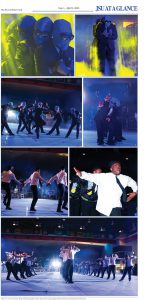 Deirdra Harris Glover
Deirdra Harris Glover
MC Contributor/Staff Writer
As many students prepared for midterms, campus police and emergency management officers prepared for the worst.
Jackson State University hosted a mass casualty drill in the Lee E. Williams Athletics and Assembly Center parking lot on Oct. 8, spearheaded by Russell Bennett, interim associate dean of the JSU School of Public Health. The drill, staged by the The Mississippi Center for Emergency Services at the University of Mississippi Medical Center, depicted the bombing of a concert or social event, similar to the bombing of Atlanta’s Centennial Olympic Park in 1996.
Carl Mangum, associate professor of nursing at the University of Mississippi Medical Center, directed the drill portion of the training. He stressed the importance of training local emergency-related professionals to work together in times of disaster or other dangers.
“With all the things going on in the country, we don’t need to wait on the government to come save us. We must be able to take matters into our own hands until help arrives.”
Trainees learned to assess an unknown scene, prioritize patients, and other onsite protocols. Participants included law enforcement, emergency medical responders, hospital nursing staffers and emergency management professionals. The exercise even included roleplaying medical staff who were in shock or otherwise impaired at the scene, so professionals could learn to care for their own. The mass casualty drill scenario is a part of the core curriculum of the Advanced Disaster Life Support training course provided by the University of Mississippi Medical Center.
Willie Gray, Jr. was a firefighter for 25 years before he accepted the emergency manager position at JSU.
“This training is valuable to JSU officers because they will know what to expect and what to expect when medical personnel arrive on campus in the event of an emergency. No matter what kind of disaster, there will always be injuries and whatnot,” said Gray.
Gray adds that “JSU campus police have some nurses here, a hazardous materials (HAZMAT) person, and people from the Department of Public Health affiliated with the campus,” all of whom add significant knowledge and resources to campus emergency response. Campus responders attend training as often as they can to increase their skill base.
Many students polled on campus were unaware of JSU’s emergency plan. Th’marves Brooks, a junior psychology and speech communications major from Jackson, Miss. says that even though he has a military background and feels prepared, he isn’t sure other students know what to do if an emergency strikes. “I think the JSU app could be a way of alerting students and giving instructions.” Students may enroll to receive JSU Emergency System information by updating their personal information in JSU P.A.W.S.
Mangum said that students can play a pivotal role in disaster and other emergencies. by being aware of their surroundings, and speaking out if something seems unusual. “Situational awareness is key, and ‘if you see something, say something,’ are words to live by.”
Gray recommended that students, faculty and staff wanting to learn more could join JSU’s Community Emergency Response Team (CERT), founded by . CERT is a program that helps teach citizens to be knowledgable leaders in times of emergency. JSU’s CERT program has trained 240 individuals since January, 2000.
Emergencies are chaotic situations, despite any amount of training a person may have. Mangum spoke from experience. “As a responder, my advice to anyone in an emergency is to get out. Run, get away. Others may have training or instincts that will kick in when danger arises, but if you have a chance to get away, do it.”
All photos by William Kelly III.









Be First to Comment